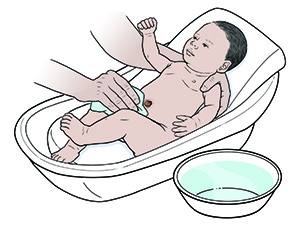Bathing Your Newborn
Until your newborn’s umbilical cord falls off, sponge baths are the best way to bathe your baby. Gather supplies, including diapers and clothes, ahead of time. This could include:
Always check the water temperature before starting the bath. It should be warm but not too hot to cause burns. The American Academy of Pediatrics advises keeping your hot water heater set at no higher than 120°F (48°C) .
Bathe your newborn every 2 to 3 days, using the steps below as a guide. You can wash the diaper area more often as needed to keep the baby clean.

Important
Never leave your baby alone near the water—not even for a few seconds! If you must leave the room during a bath, always take your baby with you.
Step 1. Wash your baby’s face
-
Use warm water on a clean, soft cloth or cotton ball. Do not add soap.
-
Wipe the eyes gently. To prevent infection, use a fresh cotton ball or a clean part of the cloth for each eye. Wipe from the inner corner of the eye outward.
-
Wash behind baby’s ears and under the chin.
Step 2. Bathe the body, arms, and legs
-
Place a small amount of mild, unscented soap on a clean, wet cloth.
-
Clean between any folds of skin.
-
Uncurl baby’s fingers and wipe the palms. Wash under baby’s arms and behind both knees.
-
Try to keep the baby’s umbilical cord dry. Uncover the area by folding the diaper under the umbilical cord so that air can help keep it dry. Dressing your baby in loose clothing will also help keep the area dry.
-
If your baby’s umbilical cord gets dirty, clean it with water and allow it to air dry.
-
Give your baby sponge baths until the umbilical cord has fallen off and the area is healed. If it gets wet, expose the area to air so it can dry.
Step 3. Wash your baby’s bottom
-
Bathe baby’s bottom after the rest of the body.
-
Wash girls from front to back only.
-
Never push back the foreskin on an uncircumcised penis.
Step 4. Take care of baby’s scalp
-
Gently rub or comb your baby’s scalp each day.
-
Wash baby’s scalp 1 or 2 times a week. Use a mild, no-tears shampoo. This can prevent cradle cap. This is a skin rash that is like dandruff. It is common in infants. You can wrap your baby in a warm towel and then wash their scalp and hair.
-
Newborns rarely need lotions or powders. If you want to use a lotion, choose a hypoallergenic one. If you choose to use powders, apply the powder to your hands first. Then rub it on your baby's skin. If the baby breathes in the powder, this can cause lung problems.
Online Medical Reviewer:
Donna Freeborn PhD CNM FNP
Online Medical Reviewer:
Heather M Trevino BSN RNC
Online Medical Reviewer:
Liora C Adler MD
Date Last Reviewed:
11/1/2022
© 2000-2025 The StayWell Company, LLC. All rights reserved. This information is not intended as a substitute for professional medical care. Always follow your healthcare professional's instructions.